LÄTHER - BABY SNAKES - HALLOWEEN 77: BOXES AND CONCERT FOOTAGE #1
LÄTHER (1977 and 1996)
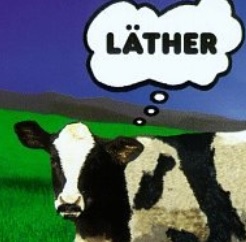 When Warner Bros. took notice of Zappa's deal with Mercury-Phonogram to release "Läther" at the end of 1977 they obstructed
its manufacturing, because they by now had decided to release "Zappa in New York" themselves the coming year.
Zappa felt infuriated and took the "Läther" tapes to the radio station KROQ-FM. The entire content was broadcast
in December in Zappa's presence, where he stimulated the listeners to copy everything on cassette tapes, since he thought
that Warner Bros. had no rights to it. In a way you can thus say that "Läther" was officially released with this radio broadcast;
everybody who had made a cassette tape recording himself could call himself a legal owner of a limited edition. Historically it is
by all means a 1977 project. That bootleggers would
seize the opportunity to spread out copies was a to be expected side effect.
When Warner Bros. took notice of Zappa's deal with Mercury-Phonogram to release "Läther" at the end of 1977 they obstructed
its manufacturing, because they by now had decided to release "Zappa in New York" themselves the coming year.
Zappa felt infuriated and took the "Läther" tapes to the radio station KROQ-FM. The entire content was broadcast
in December in Zappa's presence, where he stimulated the listeners to copy everything on cassette tapes, since he thought
that Warner Bros. had no rights to it. In a way you can thus say that "Läther" was officially released with this radio broadcast;
everybody who had made a cassette tape recording himself could call himself a legal owner of a limited edition. Historically it is
by all means a 1977 project. That bootleggers would
seize the opportunity to spread out copies was a to be expected side effect.
"Läther" got officially released on CD by the Zappa Family Trust in 1996. The included reel content pages show how Zappa
had reordered the material, and - which makes it more interesting - that he was already changing the content compared to the W. Bros. tapes (excerpt below
to the right with the titles of side one in his own handwriting). The latter makes "Läther"
a set that's more than a re-release of the W. Bros records: new songs were added and the two pieces with rearrangements of the "200 Motels" scores were left out.
The Zappa Family Trust made a good move by adding some bonus tracks themselves on their first Rycodisc issue, the one with a cow on the cover (outtake above, designed by
Steven Jurgensmeyer). It made "Läther", besides being a reissue, also a little new CD upon its own merits. For some reason the bonus tracks aren't included in the 2012 re-issue,
the one with Zappa covered with cream over his face on the cover.
Pieces unreleased on CD before:
- Duck duck goose
- Down in the dew
- Leather goods
- Revenge of the knick knack people
Duck duck goose
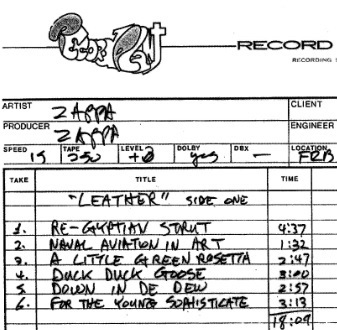 The "Duck duck goose" section from below contains an acoustic ensemble or orchestra, next to the rock band, possibly overdubbed over the acoustic track.
When this orchestral part was recorded remains unclear. It has a bass motif following the
blues scheme in E Mixolydian, while the orchestra is playing an enlarged chord and some melodic movement.
The "Duck duck goose" section from below contains an acoustic ensemble or orchestra, next to the rock band, possibly overdubbed over the acoustic track.
When this orchestral part was recorded remains unclear. It has a bass motif following the
blues scheme in E Mixolydian, while the orchestra is playing an enlarged chord and some melodic movement.
Duck duck goose, section (midi file).
Duck duck goose, section (transcription).
The held enlarged chord is I 9th in bars 2-6 and
VII 9th in the remaining bars, played in the form of stacked fifths (plus a third the second time).
With these chords being held, the bass following the blues pattern and the lead melody moving freely over it, you get
a harmonic field using all kind of combinations of notes from the E Mixolydian key. It's this aspect that makes
"Duck duck goose" sound interesting: a combination of traditional blues with modern harmonies.
Down in de dew
The opening theme of "Down in de dew" is another example of Zappa's fondness
of odd rhythms and metres. Here it's achieved via a larger syncopic figure on beats 3 and 4 of
the 4/4 bar and a bar in 14/32.
Down in de dew, theme (midi file).
Down in de dew, theme (transcription).
Bar 1 is difficult to assign to a specific key. It tends towards a I-V
progression in B during
beats 1 and 2, and I-VI in C# minor during beats 3 and 4. Thus I've notated it in B.
Bar 2 is in A Dorian, when you follow the bass pedal note, and bar 4 is chromatic. The lead melody in bars 2-5
is played via two rhythmically parallel melody lines. They move in the same manner, though the intervals between them vary.
It introduces a guitar solo, which Zappa first used for a promotion cassette called "The Guitar world according to Frank Zappa".
Leather goods
"Leather goods" belongs to the four bonus tracks, that have been added to "Läther" by the ZFT, with this title and "Revenge of the knick-knack people"
being unreleased material (except for some snippets). "Leather goods" is an impressive guitar solo. It can roughly be subdivided into the following blocks:
- 0:00 Collage.
- 0:34 First guitar solo, without the band. During its start you can hear it's a live recording. The first five bars are shown in the example below. During this block Zappa is applying echoing aftersounds for the guitar notes
he's picking, letting the echoing notes turn up left and right in the stereo field while the main line (staff 1) is double-channeled. How this is achieved technically I can't tell.
It is possible to imitate it in both a transcription and a midi file. The echoing in bar 1 is such that it seams to direct a 4/4 meter, at least Zappa is playing in 4/4.
The scale is D Mixolydian, sometimes because of a D chord, mostly because of a D being used as some sort of a pedal note, as in bar 3 (though challenged by the lower
sustained G). A C first turns up at 1:16, being natural.
Leather goods, 0:34-0:53 (midi file).
Leather goods, 0:34-0:53 (transcription).
- 3:31 The band joins in after Zappa has indicated a chromatically descending line for the accompaniment. He himself plays two sets of four notes F-E-Eb-D,
followed by C-B-Bb-A. The bass picks this up as D-Db-C-B followed by A-Ab-G-Gb. The soloing itself is diatonic, to a degree attributable to D Dorian, with D being
the opening note of the bass line and the note where the solo comes at rest at 4:02.
- 4:08 Second solo without the band, now without the echo effect.
- 4:59 The band joins in again with a vamp, the scale being D Mixolydian.
- 5:57 "... you've got an upset stomach ..."
- 6:00 End
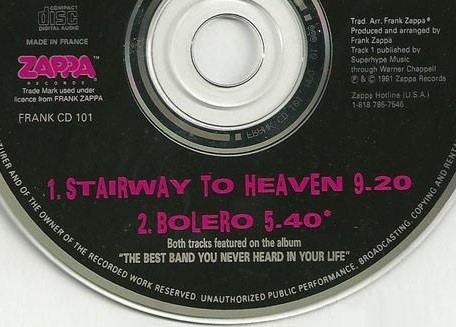
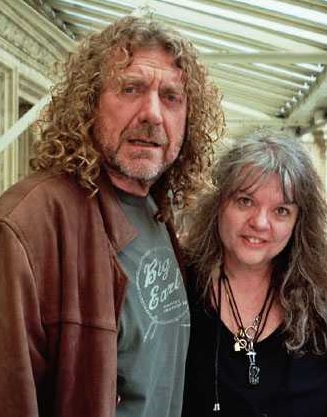
The two vamps that are being used during "Leather goods" are references to Led Zeppelin songs, "Dazed and confused" and "Whole lotta love".
In 1988 Zappa would cover their best known song, "Stairway to heaven", that got released as a promo single in combination with a rock band arranged of Ravel's "Bolero".
Both tracks stem from "The best band you never heard in your life" CD from 1991.
To the right an outtake of a photo with Robert Plant and Gail Zappa from 2006 (http://www.united-mutations.com/z/gail_zappa.htm).
Revenge of the knick knack people
"Revenge of the knick knack people" is the second specimen that the ZFT added to "Läther", with the liner notes explaining how it was found by looking at tapes
surrounding the "Läther" reels. This is the only track where no information is given who's playing on it. The liner notes state that everything was recorded between 1973 and 1977, though possibly
not applying to this track.
Revenge of the knick knack people, 0:52-1:02 (midi file).
Revenge of the knick knack people, 0:52-1:02 (transcription).
This title is entirely a collage piece of mostly percussion sections and mutated vocals. The fragment above is the only fragment with more regular music, a little pastiche part with
a piano playing in C in standard 4/4. It's basically a I-II alternation with additional woodblock notes played on top of it in an improvising manner. It sounds as sped up.
At Society pages, 1990 #6 (www.afka.net/Articles/1993-06_Society_Pages.htm), you can read that Zappa describes this track as "a sound object I wanted to make, just choppin' tape together, and then, since
there was no way to release it anyplace, I thought people might enjoy hearing it, and we used it to open the show". He's not sure about the title he then used, possibly "Curse of the knick-knack people".
Early versions of pieces released on album between 1979 and 1981:
- A little green rosetta
- For the young sophisticate
- Tryin' to grow a chin
- Broken hearts are for assholes
A little green rosetta - Ship ahoy
"A little green rosetta" is a two bar progression, each bar repeated once, over a movement of four chords. It's
alternating IV-V-IV and I-IV-I in A. The bass notes of the piano are alternating B and A. It can also be seen as B Dorian,
but the progression sounds more like a cadence in A.
It's a rather easy basis, fit to improvise lyrics along it. This is done extensively
on the later "Joe's garage" version of "A little green rosetta (1979)",
of which the theme is included in the corresponding section. The 1979 version has many more people participating.
Because of the additional bass line from 1979 I'm calling that version Dorian and this bass let's the meter start at the syllable "-ta" from "rosetta",
instead of the word "green", as I've notated it here. I transcribed the 1975 version in 2009 and the 1979 version in 2023.
With hindsight I would also notate the 1975 with bars beginning at the "-ta" syllable.
On "Läther" the improvisation element is limited to singing around the line "A little green rosetta,
makes a muffin feeling better", before the musical progression of "A little green rosetta" gets cut off
abruptly for a section from the later "Ship ahoy" solo from "Shut up 'n play yer guitar".
Green rosetta/Ship ahoy, section (midi file).
Green rosetta/Ship ahoy, section (transcription).
For "Ship ahoy" Zappa made use of a guitar effect causing
irregular aftersounds. Halfway this solo he temporarily set this effect off and it is at this point that the solo falls
in during "A little green rosetta" on "Läther". The transcribed "Ship ahoy" section begins in D Mixolydian (the part with an F#)
and continues in D Dorian (the part with F natural). The midi file above is from the section with bars without an aftersound.
"Ship ahoy" stems from the 1976 winter tour with a couple of shows in Japan. The "Green rosetta" intro must even be older,
with George Duke on keyboards. George had left the band in 1975.
Both "Duck duck goose" and "A little green rosetta" are smaller collages. The first containing various sections, the second
being made up of two blocks. Zappa saying "whereupon the door closes violently" is probably a phrase that got overdubbed
later on as a little bridge between the two sections of the collage.
For the young sophisticate
"For the young sophisticate" begins with an instrumental intro for half a minute. Below are its first 12 seconds, bars 1-7, with Zappa playing a little solo, as he's
also doing during much of the remainder of this song. At 1:42 you can hear him imitate Woody Woodpecker on guitar after the lyrics went "because he's a young sophisticator ...
so sophisticated". The scale of this song fluctuates. In the example below the E turns up first as flat, so I've notated it in
F Mixolydian, but with the E being natural just as often, notating in F major is just as viable. Other notes are getting altered too.
For the young sophisticate, opening (midi file).
For the young sophisticate, opening (transcription).
"For the young sophisticate" first reached the public with the live version from the 1981 "Tinsel town rebellion" CD. It lasts half a minute less on
"Tinsel town rebellion" with the intro and outro being shorter. Otherwise there are no major changes. Ricky Lacelotti can be heard to sing the side theme
on "Läther" ("Would you still love me if my hear grew?"). With also Ralph Humphrey on drums it probably goes back to 1973, when Ricky participated on "Overnite sensation".
Broken hearts are for assholes
In this study you can find about all imaginable subdivisions of a 4/4 meter. Really odd ones as in "Down in the dew" from above, irregular rhythmic groupings
during "The black page", etc.
In case of "Broken hearts are for assholes" you can find many forms of syncopes and pauses upon the downbeat, like:
- Bar 1, sung part: syncopes at beats 2 and 4.
- Bar 2, chords: syncope at beat 3; the chords start at tick 2 of beat 1.
- Bars 8-9, sung part: the vocals start at tick 2 of beat 1.
Broken hearts are for assholes, 0:18-0:42 (midi file).
Broken hearts are for assholes, 0:18-0:42 (transcription).
Like the previous song, this one fluctuates as it comes to its scale. The example is notated in A Mixolydian, because it starts this way in bar 1. With the C turning up as sharp and natural, notating in A Dorian is just as well possible.
The chord progression of the central riff from bar 2 is C-G-D-A, a parallel movement of major triads.
The song depicts broken hearts misery in general, seeking refuge in gay bars, after which it turns over to taking the word asshole literal. At the end it switches
over to women. Quite obviously this song was meant to be offensive, but with sufficient humor in it to compensate for it. The description of extravagant gay sceneries is well done,
as they were happening at the Grape (The gilded grape, a real club in New York from the seventies). The Grape also turns up in "Them or us, the book", as the fictional
The new gilded grape, a gay bar in Jerusalem (chapter 4).
The song ends with Patrick O'Hearn commenting "I knew you'd be surprised", though it's
not on the "Have I offended someone" compilation from 1997.
Tryin' to grow a chin (1977)
Like the previous track, "Tryin' to grow a chin" is an earlier recording of a song that would find its premiere on "Sheik Yerbouti".
In the corresponding section I've included some comment upon two "Tryin' to grow a chin (1979)"
examples from the Ludwig study. Here I'm representing the instrumental interlude from the song.
Tryin' to grow a chin, 1:30-1:58 (midi file).
Tryin' to grow a chin, 1:30-1:58 (transcription).
Bars 1-2 are the lats two sung bars before the interlude begins:
- Bars 3-10: two times a chord progression with D-A-G.
- Bars 11-16: Bm-F#-Bm-G-C-D.
- Bar 17: transition to the sung part.
Like the examples from the Sheik Yerbouti section, the interlude doesn't belong to one particular scale, being caused by the parallel playing of major triads.
Only the Bm chord is a minor triad. Without full scales it remains poly-scalar in this case, also for bars 3-10 one could argue if the D or the G should be seen as the tonic.
Re-editing and remixes:
There are various examples of forms in which some re-editing and remixing has taken place. The two most notable ones are
the original drum parts by Chester Thompson versus Chad Wackerman on the "Sleep dirt" CD. The other one concerns the three
original instrumental tracks from the same album, that on CD got a vocal overdub by Thana Harris.
Regyptian strut intro (1977)
Another feature of the "Läther" album is the insertion of mini-collages, as they can also be found on "Shut up 'n play yer guitar".
The "Läther" version of "Regyptian strut" opens with a relatively longer collage, lasting 22 seconds. It's not meant to be transcribed,
nor can it be represented properly in a midi file. This collage also serves as the album opener.
Regyptian strut, 0:00-0:17 (transcription).
It combines spoken texts and bits of instrumental music. "Bars" 2-8 from the example above contain a dialogue between a father and a son, confessing
his interest in leather. Not included in this example is the end of this dialogue with the father reacting with "don't be ashamed".
"Bars" 9-13 are all instrumental, sped up and mutated, thus not recognizable anymore as how it was initially recorded.
After this collage the written song begins as on "Sleep dirt" (see the corresponding section).
The idea of releasing multi-record boxes lived in Zappa's mind since 1970. "Läther" as a four record set was almost the first to reach the market,
with some hundreds of test pressings already made. I haven't heard of anyone with a copy that slipped out before they had to
be destroyed. There are some people however who seem to own the first pressing of "Zappa in New York", with "Punky's whips"
still on it. Of that one some copies had already reached the stores, before W. Bros decided to withdraw it. The behaviour of
this company becomes ridiculous and short-sighted at this point. Even if they didn't care about the content of their records
at all, in the long run they would have come out better if they would have let Zappa serve out his contract normally.
Triple records appeared with "Shut up 'n' play yer guitar" and "Thing-Fish", to be surpassed by the three big ones of the
"The old masters" re-releases of the MGM and W. Bros. records. These soon became obsolete by the upcoming CD as a new medium.
The next big project, the "You can't do that on stage anymore" series of six double CDs, seemed to be pretty massive as it is. The ZFT however
has shown that there's much more live material, worth releasing.
THE OLD MASTERS
"The old masters" are a re-release of the albums from 1966 through 1976, without the United Artists production "200 Motels". Today they are available as CDs, and, since there continues to be a small
market for vinyl records, some also as individual albums. As boxes they aren't available anymore. These boxes have release numbers of their own
in the official catalogue. Probably not the main reason, but, regarding content, there was also an argument to do so:
- Two have an extra "Mystery disc", later on also made available by the ZFT on CD as release #68.
- Various albums got remixed and sometimes re-edited.
Usually the difference with the first vinyl versions is minor to neglectable, but there were also instances where it had an impact on the compositions.
Examples in this study with examples from both versions concern:
- "The idiot bastard son". For "We're only in it for the money" Zappa newly recorded the bass and drum part in 1983. Today's CDs contain the 1968
recording again, while "Lumpy Money" contains the 1983 version.
- "No, no, no" and "Stuff up the cracks". The same happened with "Cruising with Ruben & The Jets". The current CD has the 1983 version on it,
"Greasy love songs" contains the original 1968 recording.
- "I promise not to come in your mouth". Not getting reached at on "The old masters", but "Zappa in New York" knows version differences between the original album, the "Läther" edition and the current CD.
The Deluxe version by the ZFT includes the original album version.
While the number of version differences of songs between albums and scores (when available) already can create confusion, the differences
between first and second releases of the same album further contribute to this confusion. Mostly the first vinyl pressings aren't directly available anymore,
but quite a lot are circulating among the older fans. Sometimes the ZFT includes the original vinyl version in their commemorative sets, as with "Freak out" as
CD one of "MOFO".
The old masters, box I (official release #43, 1985).
Freak out!.
Absolutely free.
We're only in it for the money.
Lumpy gravy.
Cruising with Ruben and the Jets.
The "Mystery disc".
The old masters, box II (official release #46, 1986).
Uncle Meat.
Hot rats.
Burnt weeny sandwich
Weasels ripped my flesh
Chunga's revenge
Fillmore East - June 1971
Just another band from L.A.
The "Mystery disc".
The old masters, box III (official release #49, 1987).
Waka/Jawaka.
The grand wazoo.
Overnite sensation.
Apostrophe (').
Roxy and Elsewhere.
One size fits all.
Bongo fury.
Zoot allures.
BABY SNAKES - HALLOWEEN 77
Baby Snakes was premiered in 1979 as Zappa's second movie. Its core is concert footage. Footage from the sixties would appear in the 1987 "Uncle meat" movie and the "Does humor belong in music" video presents the band from the eighties. The Roxy concerts from 1973 got filmed as well, but went mostly unused till 2015. There are various TV shows that feature Zappa's band. There must be a great deal of material present in the vault. The ZFT has for instance released the "The torture never stops" DVD, taken from material once used for a MTV broadcast of a Zappa concert. "Baby snakes" opens with backstage stuff, clay animations by Bruce Brickford, some cartoon minutes and then is followed by the Halloween concert at the Palladium from 1977. The movie fared badly in the cinema and got reserved reviews, though it did win a prize at the First International Music Film Festival two years later. In the eighties the film became available on video and more recently on DVD, so maybe it's getting a second chance. Personally I find it excellent. What Bruce is doing with the clay is fascinating and the concert goes on fine. The crowd was enthusiastic and the interaction with the public worked out well. Literally physical during the "Black napkins" solo, touching the hands of people in the front row, and caressing a girl with the letters Zappa written on her forehead during "Disco boy". Zappa thanked them explicitly with "I have to say this, I really appreciate this".
Punky's whips (1977)
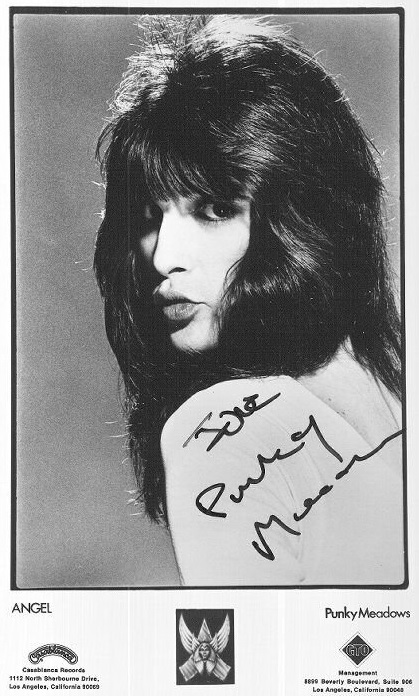 In 1983 a soundtrack was released on album, premiering "Punky's whips", the song that Warner Bros. wouldn't include in their
"Zappa in New York" version. He made no secret about his problems with Warner Bros. when performing "Titties and beer":
"I've been through hell. I was signed to Warner Brothers for eight fucking years". Former Mother of Inventions bass player
Roy Estrada returned for making Miss Pinky puke because of Warner Brothers and redoing the vocal parts like he did on
"Weasels ripped my flesh". He's in the movie, but not on the CD.
In 1983 a soundtrack was released on album, premiering "Punky's whips", the song that Warner Bros. wouldn't include in their
"Zappa in New York" version. He made no secret about his problems with Warner Bros. when performing "Titties and beer":
"I've been through hell. I was signed to Warner Brothers for eight fucking years". Former Mother of Inventions bass player
Roy Estrada returned for making Miss Pinky puke because of Warner Brothers and redoing the vocal parts like he did on
"Weasels ripped my flesh". He's in the movie, but not on the CD.
Punky's whips (1977), section (midi file).
Punky's whips (1977), section (transcription).
"Punky's whips" is another example of a multi-theme, multi-rhythm and multi-tempi composition. The transcribed section begins with some
normal rock bars in 4/4 and then proceeds with note strings in various odd meters. In the 14/32 and 17/32 bars the band is
playing up and down a scale. The 18/32 bar goes in swing time. The 33/32 bar is the weirdest one. The notes are jumping
around over an odd rhythm, played by a 9th chord. If you take the low Ab as key note, the scale would be Ab and the notes
(9th chord plus the melody) would be forming any combination within this scale. With the next bar, not transcribed here, we get back to normal.
Such an odd 33/32 bar functions the better within an environment that, compared to it, is relatively normal.
On the DVD Zappa and Adrian Belew show how
its energy can make you want to dance. It's both typical and untypical of Zappa. It's typical of him to take such steps
and it's untypical in the sense that you don't have examples that do exactly the same.
The 1977 version of this section differs from the 1976 version in the sense that the bars don't get
repeated and that the instrumentation is different. In the Zappa in New York section, I've included the end of
"Punky's whips (1976)", transcribed from the corresponding CD. To the end
Zappa is also soloing, which by itself causes version differences.
Above: signed publicity photo of Punky Meadows, subject of "Punky's whips". See the previous section for Punky's reaction.
Below: Adrian Belew singing "Jones crusher". Source: Baby Snakes DVD.
Jones crusher
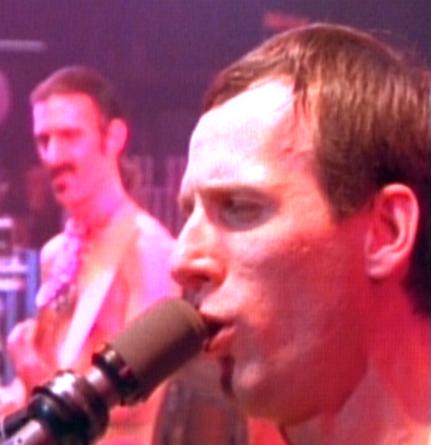 The "Baby snakes" CD is a live compilation without songs that today are unique for this release. All pieces are different versions of songs that
appeared on other CDs as well. The example below from "Jones crusher" for instance premiered on "Sheik Yerbouti", using the same
basic tracks from 1977. The "Baby snakes"
version begins with hammering on an E-A-D chord by the guitar for 8 bars.
The bass E pedal note sets the scale to E Mixolydian. Compared to "Sheik Yerbouti" the bass is more
in the foreground of the mix and the bass riff of the "Baby snakes" version only appears during the second time
the verse gets sung on "Sheik Yerbouti".
The "Baby snakes" CD is a live compilation without songs that today are unique for this release. All pieces are different versions of songs that
appeared on other CDs as well. The example below from "Jones crusher" for instance premiered on "Sheik Yerbouti", using the same
basic tracks from 1977. The "Baby snakes"
version begins with hammering on an E-A-D chord by the guitar for 8 bars.
The bass E pedal note sets the scale to E Mixolydian. Compared to "Sheik Yerbouti" the bass is more
in the foreground of the mix and the bass riff of the "Baby snakes" version only appears during the second time
the verse gets sung on "Sheik Yerbouti".
Jones crusher (1977), opening (midi file).
Jones crusher (1977), opening (transcription).
The transcription represents the opening plus the first two themes from this song.
For the first theme the bass follows the C#m7 chord and the rhythm guitar keeps pulsing the E chord, both in fast triplet
time. Both the melody and the keyboard harmony also make use of the remaining notes of the scale. The second theme
begins with the 3/4 plus 4/4 bar with now everybody following the same chord progression: G-A-D-A-A. It's followed
by three bars in reggae style. The bass alternates B and E in a regular manner, while the other accompaniment picks
either just the E (accentuated) or the D chord in an irregular order. Via the 6/4 bar we are led back to the first theme.
Conehead (1977)/Conehead instrumental
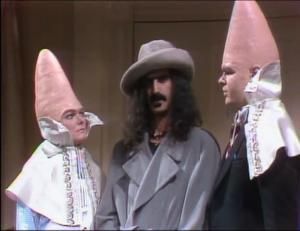 The Movie/DVD version of "Baby snakes" contains two smaller disco references. Track 16, "Conehead", opens in a peculiar
way. Zappa introduces it as "Watch me now because the name of this song is Conehead. One, two, three, four". Then "Conehead"
does indeed start on the next beat with a vamp, though not in the same tempo. Possibly this vamp is a tape playing. On the DVD
it's not clear who's doing what. Patrick O'Hearn is pouring himself in some Heineken beer, if I'm not mistaken, and gets out
of the picture when the bass part starts. Terry Bozzio
is playing the drum part, vaguely visible in the background. Adrian Belew is holding his guitar, though I don't think he's the one
playing the vamp. The chord progression in rock terms is Ab2-Bb 3rd. The pedal note at first appears to be Ab, but this one
gets overruled by the bass lick, which
sets the pedal note to Bb. The progression in traditional terms then becomes VII 9th - I in Bb Mixolydian.
The Movie/DVD version of "Baby snakes" contains two smaller disco references. Track 16, "Conehead", opens in a peculiar
way. Zappa introduces it as "Watch me now because the name of this song is Conehead. One, two, three, four". Then "Conehead"
does indeed start on the next beat with a vamp, though not in the same tempo. Possibly this vamp is a tape playing. On the DVD
it's not clear who's doing what. Patrick O'Hearn is pouring himself in some Heineken beer, if I'm not mistaken, and gets out
of the picture when the bass part starts. Terry Bozzio
is playing the drum part, vaguely visible in the background. Adrian Belew is holding his guitar, though I don't think he's the one
playing the vamp. The chord progression in rock terms is Ab2-Bb 3rd. The pedal note at first appears to be Ab, but this one
gets overruled by the bass lick, which
sets the pedal note to Bb. The progression in traditional terms then becomes VII 9th - I in Bb Mixolydian.
Conehead vamp (1977), (midi file).
Conehead instrumental (1977), 0:57-1:29, (midi file).
Conehead vamp (1977), (transcription).
Conehead instrumental (1977), 0:57-1:29 (transcription).
It's a disco type of vamp like the one for the "Black page #2", also with
a clear downbeat, but otherwise off beat. On the DVD it fades out for an interview with Adrian.
According to the bootleg collectors the 1977 "Conehead" piece was an instrumental with Zappa playing a solo over the vamp.
In 2017 the ZFT released all six concerts from the Palladium, 1977, calling this piece "Conehead instrumental". So now you've got the chance to not only hear the vamp, but examples of the complete solo.
When I transcribed the vamp, I had no idea of the piece as a whole. With the entire song at your disposal, you can hear that two 4/8 bars can better be combined
as one 4/4 bar and everything can be notated as a normal rock song: the bass and drums are using 4/4. Still the vamp is strongly syncopic and,
to a lesser degree, the bass too. It also comes out
that the bass is part of the vamp. The second example contains the first eight bars with Zappa soloing. A peculiar thing is that the guitar part sometimes
sounds as if it's made up of two melodies, played at once. This is also happening during "Bowling on Charen" (see below). So I needed two staves for notating it.
I don't have a clue of how you can create such effects. I just notice it and try to notate what I hear.
Conehead (1978)
Now it has become clear that there is no connection with the 1978 song, that's called "Conehead" too. Zappa just used the same
title for two different pieces of music. Above a screenshot from Zappa's appearance at the
Saturday night live show, with the idea of fictitious conehead people being visualized. Following next is
the opening and a section of the guitar solo from "Conehead", as present on the 1978 "Saarbrücken" bootleg from the "Beat the boots" series.
Conehead (1978), opening bars (midi file).
Conehead (1978), solo fragment (midi file).
Conehead (1978), sections (transcription).
The solo is using the opening bass theme of the song as a vamp.
The bootleggers were using the speed knob here, the pitches aren't constant. At 1:51 it jumps to another fragment of
the solo with the speed and corresponding pitch a half second lower. The first block is in F Dorian with the bass alternating
F and Bb. Syncopically in bars 1-4, on beat when Zappa starts singing.
The harmonies in the opening bars 1-4 are a blend of I 7th and IV. Staffs 2-4 begin with playing I 7th, while staff 1 already
has the upcoming IV chord as sustained notes. In the second part the key becomes E Dorian. Zappa is now soloing over the bass
lick as played in the opening bars. Other 1978 performances of "Conehead" can be found on "Halloween", with Shankar playing a violin solo,
and the "At the Circus" bootleg from the "Beat the boots" series.
A regular release of "Conehead (1981)" in Zappa's own catalogue
first came into being with the "You are what you is" album, a studio recording. See the corresponding section for an outtake.
Basement music #1
On "The lost episodes" a 1978 synthesizer composition can be found, called "Basement music #1". About this title Zappa
gets cited as follows in the CD booklet: "At the time Warner Bros. made it impossible for me to record anywhere, I had a 4-track
and decided to record in my basement. That's me wasting time with a very primitive rhythm box, a Rhythm Ace, fed into a flanger.
The music was done on a synthesizer called a Synkey. It was all played live with no overdubs." It looks like some miscommunication
happened here, for, in its standard meaning, the latter is highly unlikely. Synthesizer music like this isn't easily fit for representing it properly in a midi
file. Like for the next track, I'm calling the example below a frame instead. Getting it sound exactly as on CD it would require many more detail parameters.
Frame of Basement music #1, 0:00-0:25 (midi file).
Frame of Basement music #1, 0:00-0:25 (transcription).
In the example from above you can see a number of layers, that are making this composition polyphonic:
- Staff 1: lead melody #1.
- Staff 2: lead melody #2. Both lead melodies are diatonic, using parallel fifths.
- Staff 3: irregular chromatic melody. The notes in its lower register are woodblock-like, the higher notes sound more like whistling combined with rush.
I'm getting the impression that they are played as parallel octaves with changing volumes per note, where I've notated the register that has the upper hand in volume.
- Staff 4: chromatic melody going up and down. As far as I've checked this, it sounds as a four-bar figure, played in a loop. As soon as the lead melodies
start, it's getting difficult to discern the pitches from this melody.
The first tick from a beat of this melody is always weak, often coinciding with a bass drum beat. The second and third ticks are mostly stronger.
This part is the most specific synthesizer sound, not well approachable with a midi file. For this reason I'm above using the term frame.
- Staff 5: drums part in strict 12/16. I'm not directly recognizing patterns or loops.
I've notated this part roughly, without many details.
- Staff 6: bass part. This part enters relatively late, first in bar 11 from the example.
It's not possible to play this all at once without running stored material. Moreover the tempo is fast, while everything
remains equal all the time.
More likely is what Mike Keneally posted on alt.fan.frank-zappa in 1996 (https://groups.google.com/g/alt.fan.frank-zappa/c/s78DzwM3Ayg/m/iSnGyL0FzGMJ,
subject: FZ and his Synkey):
"I think Frank misspoke himself there - there's clearly two separate tracks
of synth on there. He told me that he played the parts manually but with
the tape at half speed, so what you're hearing is twice as fast as what he
played. When I told him it sounded like it was sequenced because the
rhythms were so precise, he said it was an illusion - if you heard the
piece at the speed at which he played it, all the little anomalies would
pop out clearly."
Basement music #2
Next to the two examples from the following Sheik Yerbouti section, the "Basement music #2" instrumental is another instance of some disco influence.
The disco aspect lies in the mechanical drum part that the rhythm box produces, a bar repeated identically
all through as often done for disco. Only the accentuated beats fail for actually calling it disco. "Basement music #2" is
more specifically synthesizer music than "Basement music #1", in the sense that the instrument is used for modifying a tone after it is initially
entered on a keyboard: the tone changes, the pitches are in glissandos and the volume keeps changing. This is also happening during "Basement music #1",
but much less. It makes it very difficult to reproduce it literally. In a transcription you would need various staves to represent different sounds and
you would have to lead the melody over these various staves, making it sort of unreadable. Secondly you would need very strong
editing equipment to be able to play it, including the undaily sounds that synthesizers produce. If you play the notes
straightforward on a midi editor as above, the result is disturbing. It still sounds nice, but leaving out the synthesizer
sound and sound effects makes the piece as good as unrecognizable. As above, I chose for the word frame, rather than calling
it a good midi representation of the original. In that sense the "Basement music" and various pieces on "Civilization phaze III"
are untypical of Zappa, because you can play about all of his music on any instrument and it still would be immediately
recognizable.
Frame of Basement music #2, opening (midi file).
Frame of Basement music #2, opening (transcription).
"Basement music #2" was first used as background
music for "Baby snakes". The original recording got included in the ZFT release "Quaudiophiliac". "Basement music #2"
is untypical of what Zappa was doing at that time, not only for its mechanical drum part, but also because of the specific
use of synthesizer effects and the way it's composed. Here you can hear that Zappa was always interested in side-steps and
new directions for his music, eventually leading to his last CD, "Dance me this", coming out as yet another surprise.
The transcribed section above of "Basement music #2" doesn't have pedal notes. The melodic accent during bars 1-6 lies on D,
so one might call it D Mixolydian.
Wild love (1977)
All concerts included at least one title where band members could improvise in turn. Only a 1974 performance of "Dupree's paradise"
reached an official album in Zappa's own catalogue unedited. Songs played like this could average between 15 and 30 minutes.
With the many ZFT releases of complete concerts, quite a few other examples have become available. During the Halloween concerts of 1977
"Wild love" got used for letting the band members solo, all six examples being present on the stick version of "Halloween 77".
Terry Bozzio's drum solo wasn't part of "Wild love". It always got included as a separate intermezzo.
The construction of this song from the 1977 October 28th concert, show 1, goes as:
- 0:00 Written part of "Wild love" with all of its themes being dealt with in the Sheik Yerbouti section of this study.
- 3:53 The "disco" vamp from 3:05 now gets used for introducing the soloing block. The bass pedal is C# instead of B at this particular point, letting the scale switch to C# Dorian.
- 4:00 A new accompanying figure in B Mixolydian enters the picture. Beginning of keyboard solo #1.
- 7:04 Keyboard solo #2.
- 7:43 Marimba & other percussion solo.
- 10:11 The accompanying figure gets restated with chords. Beginning of a synthesizer solo.
- 12:18 Guitar solo #1 with its opening as shown in the example below.
Wild love (10-28-77, show 1), 12:10-12:35 (midi file).
Wild love (10-28-77, show 1), 12:10-12:35 (transcription).
- 14:25 The accompanying figure ends, transition to guitar solo #2. Any connection with the previous is lost, it sounds as a new song beginning.
This is Zappa himself soloing, including it as an individual piece on his later "Trance-fusion" CD as "Bowling on Charen" with a couple of bars being edited out.
See the next track below.
- 21:42 Return of the written themes.
- 22:24 Additional coda, similar to the one used for "Läther" as a song. See below.
- 24:05 End.
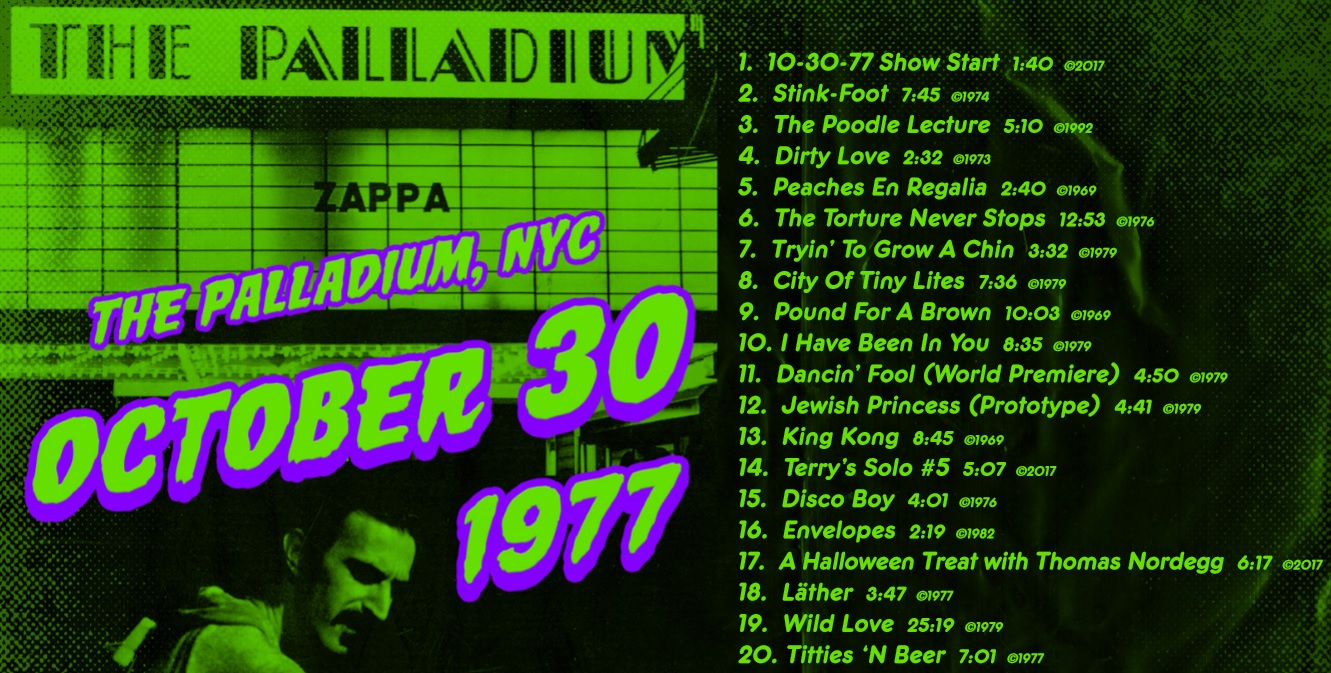
In 2017 the ZFT came out with their thus far biggest release, "Halloween 77", with all the Halloween concerts from 1977 on it.
Above a sample from the booklet as included in the 6-concerts-on-a-stick version with titles 1-20 of the tracklist
from the 30-10-1977 show (in total consisting of 30 tracks). The shows on the stick are:
- 28-10-1977 show 1.
- 28-10-1977 show 2.
- 29-10-1977 show 1.
- 29-10-1977 show 2.
- 30-10-1977.
- 31-10-1977 (Halloween night).
Next to the stick version, this issue was also made available on CD format. As a 3-CD-set it contains all of the 31-10-1977 show
and four additional tracks from the 30-10-1977 concert.
The torture never stops (1977)
Ever since "Pound for a brown", "King Kong", "Black napkins" and "The torture never stops" appeared on record, these songs kept being included in most touring setlists
as well. "Pound for a brown" and "King Kong" always got used as a vehicle for band members to improvise. "Black napkins" and "The torture never stops" have Zappa himself
improvising on guitar. "Black napkins" has a written theme, so all performances start in a similar manner. The accompaniment of the solo section from "The torture never stops"
hardly offers a reference point for solos to become comparable. It's just an A pedal in 4/4, setting the key to A Dorian. The ZFT continues to release live
recordings, so the amount of performances of these four songs keeps growing. It must be dozens by now. The complete "Halloween 77" on-a-stick-set offers you a possibilty
to listen to six subsequent executions of "The torture never stops" solos. Below are the first four opening bars of these solos. Here you can see the reality
of improvising, or, as Zappa liked to call it, building a composition in front of an audience, completely anew each show. Also over shorter periods Zappa, nor the band,
looked for figures to open the solo with in a similar way.
The torture never stops solo (10-28-1977), show 1, bars 1-4 (midi file).
The torture never stops solo (10-28-1977), show 2, bars 1-4 (midi file).
The torture never stops solo (10-29-1977), show 1, bars 1-4 (midi file).
The torture never stops solo (10-29-1977), show 2, bars 1-4 (midi file).
The torture never stops solo (10-30-1977), bars 1-4 (midi file).
The torture never stops solo (10-31-1977), bars 1-4 (midi file).
The torture never stops solos (1977), bars 1-4 (transcription).
The torture never stops (10-28-1977, show 1): the solo begins with a chord progression.
The torture never stops (10-28-1977, show 2): two alternating chords, D as an arpeggio chord, C as a normal chord.
The torture never stops (10-29-1977, show 1): Zappa plays only two notes in bar 1, possibly still adjusting something. The bass fills in bar 2. In bar 3 the solo truly begins.
The torture never stops (10-29-1977, show 2): the solo starts melodically, the more usual way.
The torture never stops (10-30-1977): the solo starts partially melodically, partially with guitar effects as feedback notes.
The torture never stops (10-31-1977): this time the solo starts calmly with several staccato notes.
One can also notice that there's hardly a time difference between the start of these solos, indicated below the transcriptions. I'm familiar with the the term absolute hearing as it comes to pitches, the ability
to remember pitches of notes pretty accurately. Like this there also exists an absolute hearing regarding tempos, the possibility of playing a song in the same tempo each night.
Bowling on Charen
"Bowling on Charen" stems from the October 28th concert from the 1977 Palladium series. It's the oldest track on the "Trance-Fusion" CD, released
in 2005 (see the corresponding section). As mentioned above you can hear that this solo was part of a lengthy "Wild love" performance,
including a number of rather unrelated solo blocks. They could be released as separate tracks too.
The "Bowling on Charen" solo by itself is made up of three blocks. Specifically the coda is more pre-conceived than usual.
- 0:00-1:04 Opening block. The solo opens with a series of variations upon a theme as presented in bar 1 from the first transcription below.
What's notated as a pick-up bar isn't really a pick-up bar, but the incomplete closing bar from the preceding song. Zappa is here using a self-created
scale, B-C#-D#-E-F#-G-A/A#. It's a variant upon B Mixolydian with the G# turned to G natural. Both A and A# get used. B as the tonic gets predominantly
established by the theme itself, that keeps returning to B as the starting point, while its tail keeps varying. The bass staff represents different
instruments: keyboard/sax in the pick-up bar, some background guitar notes during beat 1 of bar 2 and a high B by the bass guitar beginning at beat 3 (pitch notation as it sounds).
This is the only note the bass guitar plays during the opening section. The keyboard is using series of dissonant chords as you can hear for instance
during bars 3-4 from the transcription below. On beat 4 from bar 7 you have an accentuated B7 chord.
Bowling on Charen, opening (midi file).
Bowling on Charen, opening (transcription).
- 1:04-4:15 Central block with a bass notes alternation. The second example below shows the transition to and the opening of this block. Via G-A# by the bass Zappa moves
over to a B-A alternation in B Mixolydian. From bar 4 onwards the G natural has disappeared in favor of the normal G# from the B Mixolydian scale.
If one would step into this section at an arbitrary point one would be more inclined to identify it as an A-B alternation in A Lydian, a more
common alternation for Zappa's solos (see also the Shut up 'n play yer guitar section). In this case however,
the solo begins on B, the alternation and most specifically the coda end on B. So taking B as the overall tonic is the more appropriate option. A peculiar phenomena
to notice is that Zappa at some points manages to sound as if he's playing two melodic lines at once, presented via an extra guitar staff in the example below. Specifically
in bars 5-6 you've got two points with two melodic fragments sounding simultaneously. It probably stems from a combination of picking notes and a guitar effect (it
doesn't sound like a second guitar or an overdub). The theme from the opening block returns during 2:22 through 2:35.
Bowling on Charen, 1:04-1:23 (midi file).
Bowling on Charen, 1:04-1:23 (transcription).
- 4:15-5:03 Closing block. "Bowling on Charen" has a clear pre-arranged coda, a minority in Zappa's output. The 1979 "Watermelon in Easter" is another example
of such a coda rounding off a solo. Zappa's standard way of ending a solo during a concert was diminishing the pace, end on a note, and then turn around to the band,
as an indication that the next bar should be the continuation of the song the solo was part of. Sometimes Zappa would turn to the melody of the song with his guitar
playing himself, as in "Yo' mama". On CD, when a solo gets presented as an individual composition, Zappa would often simply cut it off a couple of seconds before its
actual ending during a concert.
Bowling on Charen, end (midi file).
Bowling on Charen, end (transcription).
Presented above is the second half of this ending block. The chord progression used here is:
- bar 1: transition to the second half of the coda with I-VII-I in B Mixolydian.
- bar 2: beat 4 of bar 1 and beats 1-2 of bar 2 contain an extended harmony. Zappa plays in an arpeggio manner over what you could call I 9th from B Mixolydian, while the bass
gives an A. Zappa loved applying such wider harmonies (9th, 11th and 13th chords) next to standard chords, giving him a sense of total harmonic freedom. On beats 3-4 Zappa
lands on simply the A chord.
- bar 3: beat 1 is the Bm7 chord, beat 2 the E chord and beat 3 the B chord (plus an E by the bass).
- bar 4: beat 4 from the previous bar plus this bar use the chords from bar 2 again. The bass notes are different, widening the harmony. The A chord in this case gets extended with a D# by the bass.
- bar 5: beats 1-2 can be identified as for instance Asus2 plus F# or I 11th from B Mixolydian. On beats 3-4 Zappa reaches his final chord: simply B or the I-chord
from B Mixolydian. The bass begins melodically, but also moves to a final B at the beginning of bar 6. At the end of bar 6 and the following bar (cut off a little before its end
and not included anymore in the example above) feedback notes
get the upperhand and the bass seems to hint at the return of the themes from "Wild love" (see the previous track).
Läther (title song)
Läther, as a song title, is the same composition as "I promise not to come in your mouth" from the previous section. It got renamed as the title track when Zappa assembled
the material for the "Läther" album. It appears under this new title on the ZFT releases "Läther" and "Halloween 77". In 1977 Zappa enlarged this song with an additional coda,
presented below for the composed part. It's transcribed from the 1977 October 30th concert.
Läther (10-30-77), 3:07-3:24 (midi file).
Läther (10-30-77), 3:07-3:24 (transcription).
Bars 1-7 read as an exercise in following different meters and rhythms. Next this coda continues in 3/16 for six more bars, after which Zappa starts improvising without
a meter over a sustained chord. Harmonically there are pedal notes and reminiscences of diatonic scales, but not stable enough to assign bars to specific keys.
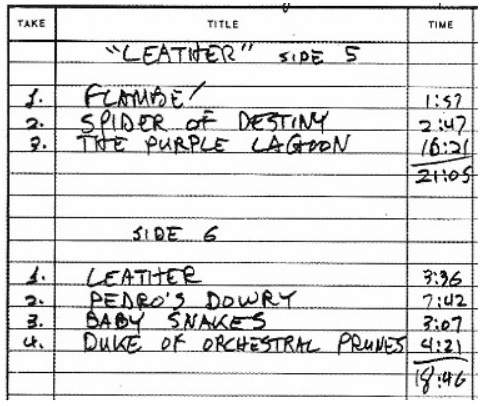 Sides 5-6 from the Läther reels with "I promise not to come in your mouth" being re-titled to "Leather"
in Zappa's own handwriting. See the typed setlist from the "Zappa in New York Deluxe" booklet for the use of the original title when played in 1976.
"Läther" is a German spelling that would get pronounced as "Leather", though not a German word (leather would be Leder in German).
"The ocean is the ultimate solution" got renamed as "One more time for the world" on side 7.
The ZFT is using the original title of that particular song on their "Läther" CD. Seen its duration and absence of the title "The ocean is the ultimate solution"
on the reels, "One more time for the world" has to be the same song.
Sides 5-6 from the Läther reels with "I promise not to come in your mouth" being re-titled to "Leather"
in Zappa's own handwriting. See the typed setlist from the "Zappa in New York Deluxe" booklet for the use of the original title when played in 1976.
"Läther" is a German spelling that would get pronounced as "Leather", though not a German word (leather would be Leder in German).
"The ocean is the ultimate solution" got renamed as "One more time for the world" on side 7.
The ZFT is using the original title of that particular song on their "Läther" CD. Seen its duration and absence of the title "The ocean is the ultimate solution"
on the reels, "One more time for the world" has to be the same song.
The poodle lecture - Is that guy kidding or what?
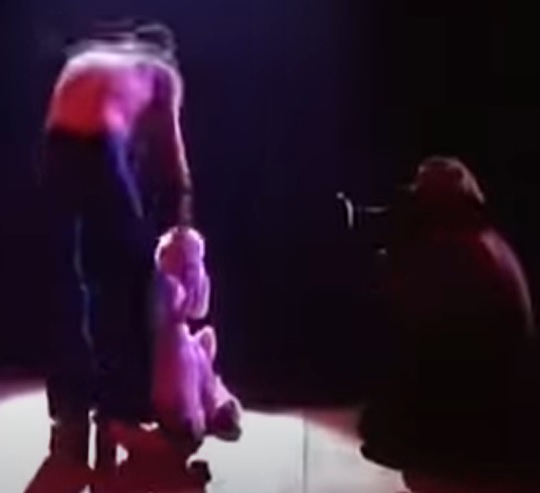 For "The poodle lecture" the main vamp from "Stink-foot" is getting used all-through, the way it was played during the 1977-8 tours.
The example below contains the first five bars. It's a story for entertainment purposes
with Zappa only talking to the audience, beginning in bar five of the example. The subject is working out in details an idea that first
got expressed during "Dirty love" from "Overnite sensation", namely how a poodle can be sexually stimulating. He carried a toy poodle with
him during the 1977 tour to briefly visualize it on stage (image to the right).
For "The poodle lecture" the main vamp from "Stink-foot" is getting used all-through, the way it was played during the 1977-8 tours.
The example below contains the first five bars. It's a story for entertainment purposes
with Zappa only talking to the audience, beginning in bar five of the example. The subject is working out in details an idea that first
got expressed during "Dirty love" from "Overnite sensation", namely how a poodle can be sexually stimulating. He carried a toy poodle with
him during the 1977 tour to briefly visualize it on stage (image to the right).
The poodle lecture, opening bars (midi file).
The poodle lecture, opening bars (transcription).
This example is from the 1977 Halloween concerts and can also be seen during the "Baby snakes" movie. On CD it can be found on "YCDTOSA Vol. VI", with
this example containing the first 15 seconds.
It goes the same as the "Stinkfoot (1978)" example from the Halloween section of this study.
Thus also here in C Mixolydian with a 12/8 meter. The improvised element is making the difference.
Is that guy kidding or what?, 1:20-1:36 (midi file).
Is that guy kidding or what?, 1:20-1:36 (transcription).
Also recorded at the 1977 Halloween concerts is "Is that guy kidding or what?". Like the previous song it can be found on "YCDTOSA Vol. VI".
Zappa introduces it as a fresh song, hardly rehearsed, but good enough for using it as a vamp for telling another story to the audience. In
this case it's about the appearance of Peter Frampton's album "I'm in you". When you look it up on the net you can see Peter Frampton bare-chested
on the cover and it does make a really weird suggestion. In the title song of that album, however, this phrase is used metaphorically.
It eventually led to the Zappa's "I have been in you" song on "Sheik Yerbouti". See the corresponding section
for examples. At this point in 1977 the vamp is using the I-II alternation in A Mixolydian, on "Sheik Yerbouti" used during the verse.
"Is that guy kidding or what?" is part of the "Baby snakes" movie, but the connection between "I'm in you" and "I have been in you"
become only more explicit to the general public with the appearance of "YCDTOSA Vol. VI". More elaborate and brutal is the
version of "I have been in you" as you can find it on the "Hammersmith Odeon" CD by the ZFT.
